Tokujin Yoshioka designs London flagship store for Issey Miyake
Rough concrete columns are juxtaposed with bright blue aluminium panels at the soon-to-open Issey Miyake flagship store in London by Japanese designer Tokujin Yoshioka (+ slideshow + interview).
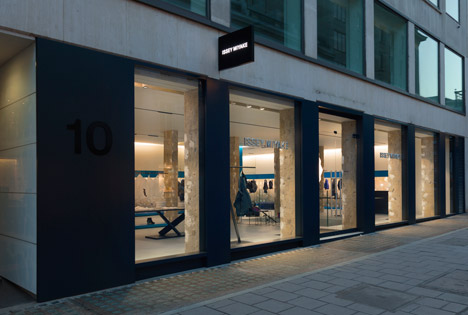
The six large panes of glass that front Issey Miyake's latest London retail offering face onto Brook Street, between the city's major shopping thoroughfares of Regent Street and Bond Street.
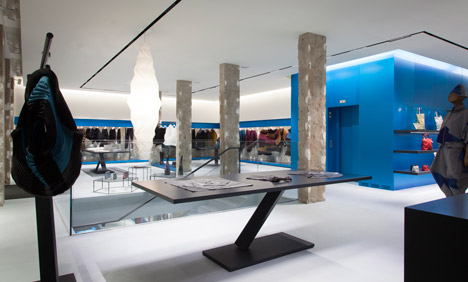
Spilt over two levels, the new 465-square-metre store houses the Japanese fashion brand's signature pleated garments and geometric-patterned bags across its various womenswear, menswear and accessories lines.
"It is very difficult to design a retail area," said Yoshioka, speaking to Dezeen at the store earlier today. "First we have a really limited period, and we also have regulations for store space, and I have to find a solution to each."
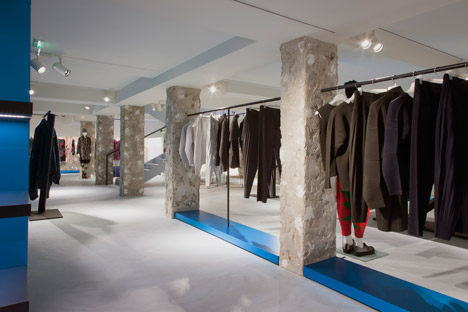
Yoshioka's design involved stripping out the fittings inside the lower two floors of the 1950s building, which were previously occupied by a bank, and leaving walls and columns bare.
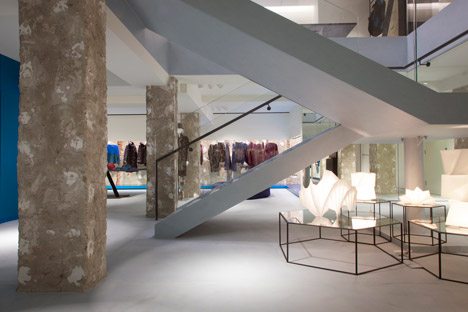
To contrast the structural elements, bright blue aluminium panels are used in strips around the edges of the space to highlight display areas.
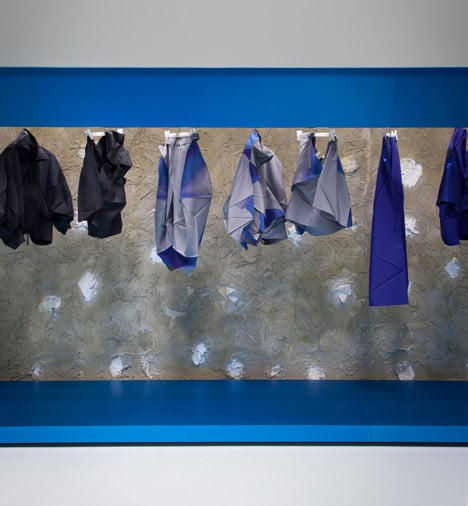
"I intended to have the contrast with the old aspect and the existing architectural environment, and having new aluminium panels that expresses the future," said Yoshioka.
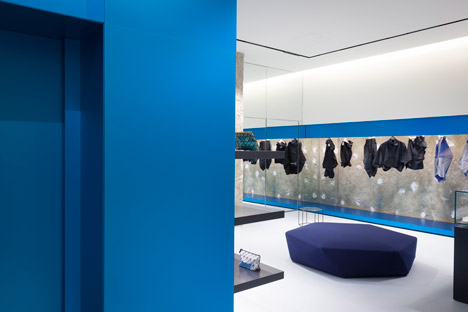
The panels also clad the lift shaft, providing a backdrop for a showcase of bags on the upper floor.
"I particularly like the idea of contrasting the old and the new," said Yoshiyuki Miyamae, creative director of womenswear at Issey Miyake, talking to Dezeen about the design.
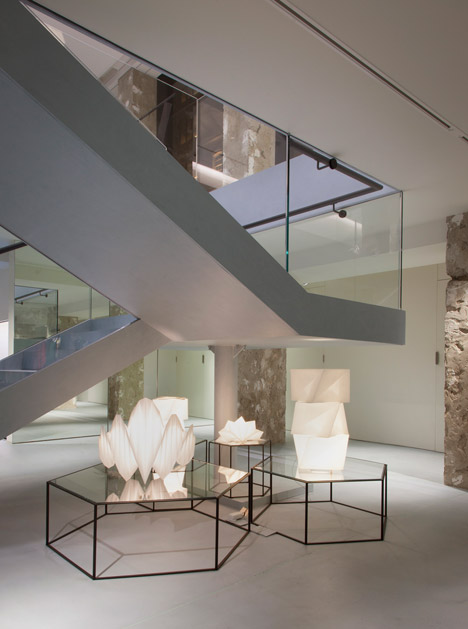
"London always preserves old environments and buildings. Yoshioka sympathetically put something very interesting, new and beautiful on top of this and the two existing together in a city like London, it almost represents London itself."
The other surfaces around the store, which officially opens on Saturday, all feature hints of blue to create a unified palette "to match and harmonise the whole space".
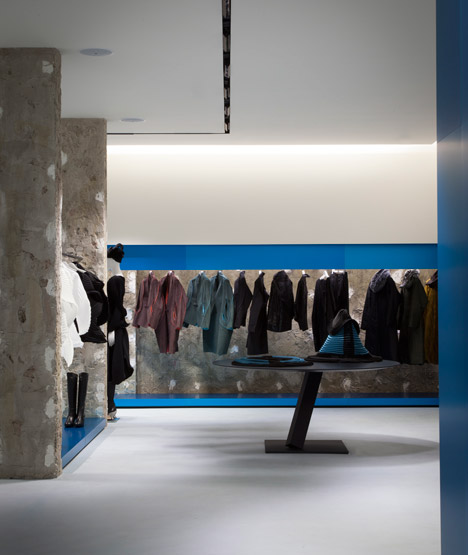
A doglegged staircase positioned in the centre of the floor plate is surrounded by glass balustrades, to allow light from the street-facing facade down into the basement.
"I love the way the huge glass windows are used," Miyamae told Dezeen. "It stands out on the street, it's very open."
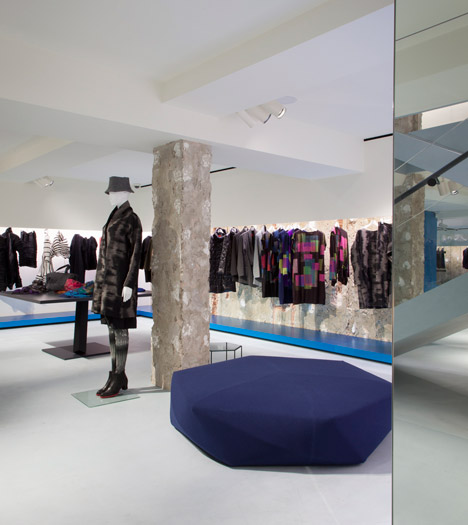
Menswear is located downstairs, where the rough concrete columns and blue panelling continue in the darker and more intimate setting.
"I'm not really interested in something like 'luxury', today, or something completely perfect," Yoshioka said. "Contrary, opposite to something perfect, I want to give something surprising, or unexpected, to the store design."
Issey Miyake's IN-EI pleated lamps for Artemide and cove lighting around the ceiling offer additional illumination around the store.
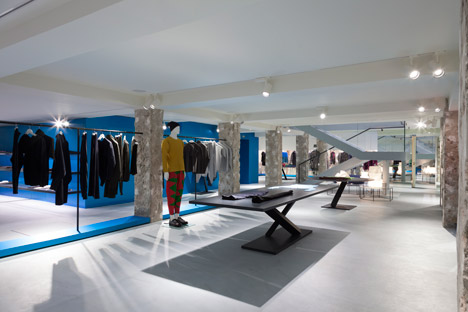
Yoshioka's tables for Desalto, which appear to be balanced precariously on angled stands, are used to display accessories and the 132 5. garments that expand from two-dimensional geometric shapes into structured wearable items.
He also created a new seat called the Brook Stool for the store, produced by Italian company Moroso. The stools are designed using the same software as the brand's garments to create a faceted effect across the upholstered surface.
"I first thought of Issey Miyake's garments as having a very graphic patterns, and thought of this hexagon shape for the sofa," Yoshioka said.
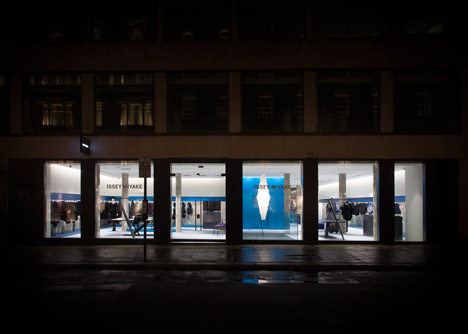
The designer has collaborated with Issey Miyake for over 20 years, completing a series of store interiors for the brand – predominantly in its home city of Tokyo – as well as watches and installations.
"Issey Miyake doesn't tell me to do and what particularly, so I'm always trying to surprise Issey Miyake and that's one way of working with him," Yoshioka said.
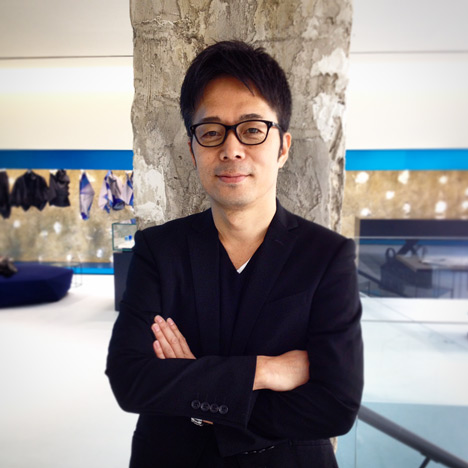
Here's the transcript of the interview with Tokujin Yoshioka, who spoke to Dezeen through a translator:
Dan Howarth: Could you explain about the story and the ideas behind the design?
Tokujin Yoshioka: First of all what I'm interested in today is two things; one is the future, and the other is the time that we have and experience as the past. I'm always thinking about the future with experimenting, and documenting the past over and over. What's curious to me is something to do with history, which nature or human beings haven't touched yet. So when I have opinions for this project the first idea was to maintain the existing architecture in equal footing to my design.
So I intended to have the contrast with the old aspect and the existing architectural environment, and having new aluminium panels that expresses the future. The theme was ambivalent.
Dan Howarth: Why did you chose these colours and materials?
Tokujin Yoshioka: I first thought of blue and green but I came to decide on blue. Every element has more or less a sense of blue to match and harmonise the whole space.
Dan Howarth: How does the design of the store relate to the clothing?
Tokujin Yoshioka: One future I perceive from the clothes of Issey Miyake is to use both technology and hand craft as values. So I want to bring the two features of integrating to the design of the store. Not only about the technology as a futuristic aspect, but to also have the traditional hand working characteristics together.
Dan Howarth: The garments are very expressive but minimal at the same time. Is that something that you tried to echo in the design?
Tokujin Yoshioka: It's been about 20 years collaborating with Issey Miyake. I was also involved in the creation of Issey Miyake before and have learned a lot directly from Issey Miyake, so today it's not about trying to make it close to Issey Miyake's vision it's more like working naturally in collaboration.
Dan Howarth: What did you learn from Issey Miyake?
Tokujin Yoshioka: I learned that he is very, very curious for something new, something he hasn't seen before. So Issey Miyake doesn't tell me to do and what particularly, so I'm always trying to surprise Issey Miyake and that's one way of working with him.
Dan Howarth: You've also designed Issey Miyake stores in other parts of the world. How does this one compare?
Tokujin Yoshioka: A combination of the existing and historic environments and aluminium has started from [Mikaye's design studio] A-Poc in Tokyo. In A-Poc I used the panel parts of cars for the interior.
In London the city also has to have something new, modern, and historical together today so I thought of this idea even for this store.
Dan Howarth: You've also designed some of the furniture for the store.
Tokujin Yoshioka: [The tables] were presented by Desalto two years ago in Milan and we made the counter to match the Desalto furniture. And the sofa right there is by Moroso, it's a new piece.
Dan Howarth: Was the sofa designed specifically for the store? Did one inform the design of the other?
Tokujin Yoshioka: I first thought of Issey Miyake's garments as having a very graphic patterns, and thought of this hexagon shape for the sofa. I was using 3D programming to try and have a coincidental shape during the experiments and tests, and stopped the process to make a shape.
Dan Howarth: And that relates to how some of the garments in the store are created using 3D technology?
Tokujin Yoshioka: Yes.
Dan Howarth: What challenges do you find most interesting about designing for retail?
Tokujin Yoshioka: It is very difficult to design a retail area. First we have a really limited period, and we also have regulations for store space, and I have to find a solution to each. But for the space I'm not really interested in something like "luxury", today, or something completely perfect. Contrary, opposite to something perfect, I want to give something surprising, or unexpected, to the store design.
Dan Howarth: What was the first project you did for Issey Miyake?
Tokujin Yoshioka: I don't remember! It was in my early 20s.
Dan Howarth: In which case, which one has been your favourite?
Tokujin Yoshioka: I have some. There's one made out of old glass, which was really new at that time. But what I'm trying to do with Issey Miyake is try to make the completion of something that looks like it hasn't been done with a lot of work, to keep it minimal.
Dan Howarth: Do you have anymore upcoming projects with the brand?
Tokujin Yoshioka: Yes in Tokyo, a store design as well.
Dan Howarth: Do you think you'll use some of the elements for this store and translate that over to Japan?
Tokujin Yoshioka: Yeah it's highly possible. I'm learning as I go.
Photography is by Antony Crolla